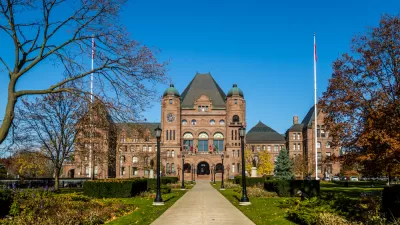Ontario Premier Kathleen Wynne made a strong case for taking decisive climate change action when she signed an historic agreement to join the Quebec program that trades carbon with California.
Much like in the United States, bold climate action is undertaken primarily by provinces as opposed to the federal government which has yet to forge a national strategy.
"Ontario Premier Kathleen Wynne on Monday signed a historic deal [onApril 13] to join Quebec’s cap-and-trade system for carbon emissions," write Jane Taber and Adrian Morrow in The Globe and Mail. "Many of the details in Ontario’s cap-and-trade system still have to be worked out over the next six months, but it is likely to look similar to the joint system run by Quebec and California."
"Climate change is one of the greatest challenges humankind has ever faced. This is about preserving a world for our children and our grandchildren,” Ms. Wynne told reporters after meeting [Quebec Premier Philippe] Couillard in his office near the National Assembly.
Wynne emphatically makes her point in the accompanying video at a press conference.
In a separate piece, Morrow explains how cap-and-trade works and how it differs from a carbon tax:
It’s a system where the government caps the total amount of carbon emissions allowed. The government then issues permits to companies, specifying exactly how much carbon that company can burn. If a company wants to burn more than its share of carbon, it must buy extra permits from other companies that have burned less.
Recently we noted that businesses in Vermont were pushing the state to enact the nation's first carbon tax, but it's increasingly looking as if cap-and-trade may be the preferred carbon pricing system, and that Canada is where progress is being made.
Once Ontario’s system is operating, 62 per cent of Canada’s population and more than half its economy will be under the same carbon market. Including [British Columbia] B.C., which uses a carbon tax instead, some three quarters of Canadians will be covered by provincial-level carbon pricing.
While the federal government is moving forward with some climate-change measures – such as new regulations to make trucks more fuel efficient, and a plan to phase out coal-fired power generation – Ottawa has adamantly refused to support carbon pricing.
“We are very clear we don’t want … what is effectively a tax on carbon which would increase the cost for consumers and on taxpayers – the cost of electricity, of gasoline, of groceries,” Finance Minister Joe Oliver [see Canadian Ministry] told reporters Monday in response to Ontario and Quebec’s deal.
“This is a bold move from the province of Ontario — and the challenge we face demands further action from other states and provinces around the world,” [Gov. Jerry] Brown said. “There’s a human cost to the billions of tons of carbon spewing into our atmosphere, and there must be a price on it."
FULL STORY: Ontario unveils cap-and-trade plans as provinces take lead on climate change

Alabama: Trump Terminates Settlements for Black Communities Harmed By Raw Sewage
Trump deemed the landmark civil rights agreement “illegal DEI and environmental justice policy.”

Study: Maui’s Plan to Convert Vacation Rentals to Long-Term Housing Could Cause Nearly $1 Billion Economic Loss
The plan would reduce visitor accommodation by 25% resulting in 1,900 jobs lost.

Planetizen Federal Action Tracker
A weekly monitor of how Trump’s orders and actions are impacting planners and planning in America.

Wind Energy on the Rise Despite Federal Policy Reversal
The Trump administration is revoking federal support for renewable energy, but demand for new projects continues unabated.

Passengers Flock to Caltrain After Electrification
The new electric trains are running faster and more reliably, leading to strong ridership growth on the Bay Area rail system.

Texas Churches Rally Behind ‘Yes in God’s Back Yard’ Legislation
Religious leaders want the state to reduce zoning regulations to streamline leasing church-owned land to housing developers.
Urban Design for Planners 1: Software Tools
This six-course series explores essential urban design concepts using open source software and equips planners with the tools they need to participate fully in the urban design process.
Planning for Universal Design
Learn the tools for implementing Universal Design in planning regulations.
Caltrans
Smith Gee Studio
Institute for Housing and Urban Development Studies (IHS)
City of Grandview
Harvard GSD Executive Education
Toledo-Lucas County Plan Commissions
Salt Lake City
NYU Wagner Graduate School of Public Service




























